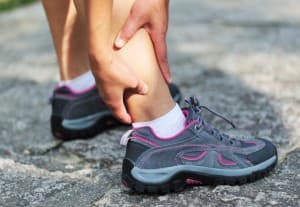What is Achilles Tendinitis and How is it Treated?
Our feet go through quite a bit- from fashionable (and painful) shoe decisions, years of weight bearing, athletic injuries and general wear and tear. At Rebound, we see a variety of foot ailments, and have the technology and expertise to get you back on your feet.
In the spirit of Foot Health Awareness Month, we want to help you keep your feet healthy and happy by providing tips and resources, events and commentary from our doctors throughout the month.
A common foot and ankle condition we see and treat at Rebound is Achilles tendinitis, a condition that affects the Achilles tendon, the largest tendon in the body. Like with many musculoskeletal injuries, Achilles tendinitis typically occurs because of overuse (often sports related) and degeneration, or wearing down with age and time.
What is Achilles Tendinitis?
When the Achilles tendon becomes inflamed, it is referred to as Achilles tendinitis. The condition causes sharp pain in the back of the leg near the heel. “As the largest tendon in the body, the Achilles tendon can withstand quite a bit, but with overuse, it can be susceptible to injury or tendinitis,” says Rebound foot and ankle specialist, Dr. C. Luke Rust. “There are two kinds of Achilles tendinitis, determined by the affected area of the tendon.”
Noninsertional Achilles Tendinitis
- This type of tendinitis happens when the middle of the tendon breaks down. The tears are small and cause the heel and leg to swell.
- Active, younger people are susceptible to this type of tendinitis.
Insertional Achilles Tendinitis
- This type of tendinitis happens when the tendon attaches to the heel bone.
- While noninsertional Achilles tendinitis most commonly affects the young and active, insertional Achilles tendinitis may occur whether or not the individual is active.
“Achilles tendinitis doesn’t necessarily develop as a result of an injury. It is essentially an overuse injury in many cases. If you’ve abruptly increased your exercise routine, or the intensity, you may experience inflammation or stress to the Achilles tendon,” says Dr. Rust. Bone spurs and aggressive exercise can also contribute to Achilles tendinitis.
What Symptoms are Associated with Achilles Tendinitis?
The most common and easily identifiable symptoms are pain, irritation and swelling.
- Pain and stiffness in the morning
- Pain along back of the leg or back of the heel
- Post-activity/exercise pain
- Thickening of the tendon
- Swelling that worsens throughout the day
- Development of bone spurs

How is Achilles Tendinitis Treated?
Many cases of Achilles tendinitis may be treated without surgery. Depending on the severity and persistence of the condition, surgery may be a proper treatment option.
“Alleviating the stress you put on your Achilles tendon is key to recovery, and that starts with rest. Decreasing the intensity of exercise and focusing on low-impact exercise that will help strengthen your calf muscles is important. By focusing on strengthening your calf muscles, you’ll reduce the weight and stress you place on the tendon,” says Dr. Rust.
In addition to cortisone injections and shock therapy treatment options, physical therapy is incredibly effective in treating the condition. Our physical therapists will work with you to create a personalized plan to recovery. There are also exercises you can do at home:
If you believe you may be experiencing Achilles tendinitis, do not hesitate to contact us online or at 1-800-REBOUND. We’re proud to serve the Portland and Vancouver metro, and we will help find the treatment plan that works best for you.
Additional Resources:
Rebound – My Aching Foot: Foot Pain Causes and Treatments
